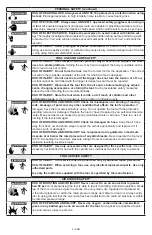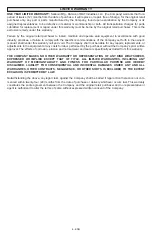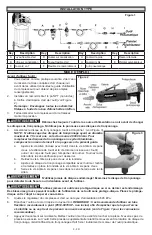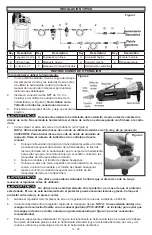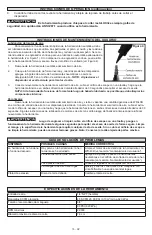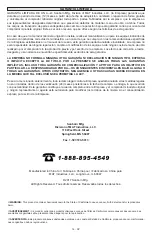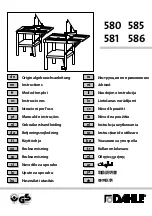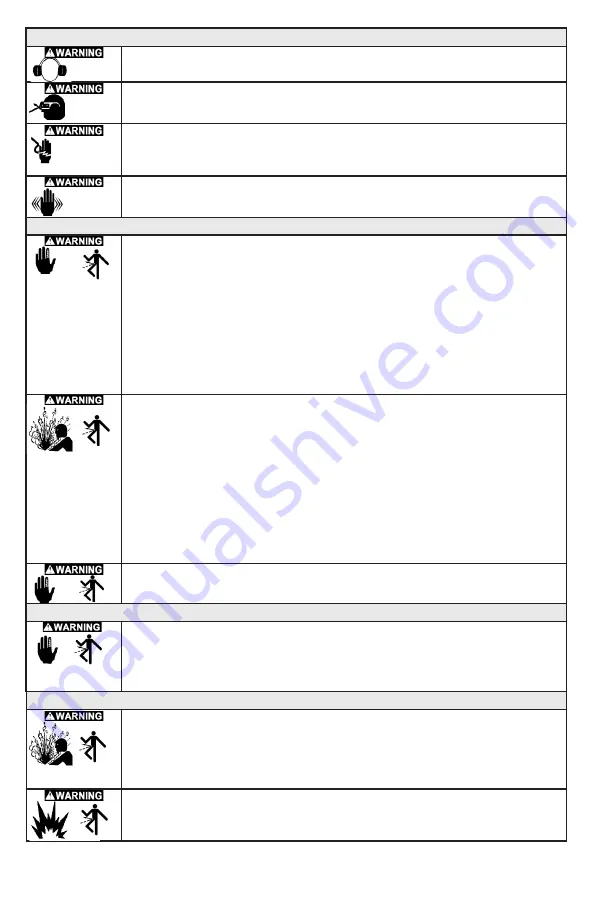
3 - ENG
PERSONAL SAFETY (continued)
RISK OF HEARING LOSS. Always wear ANSI S3.19 approved ear protection when using
the tool.
Prolonged exposure to high intensity noise is able to cause hearing loss.
RISK OF EYE INJURY. Always wear ANSI Z87.1 approved safety goggles when using an
air tool.
Air powered equipment and power tools are capable of propelling materials such as
metal chips, sawdust, and other debris at high speed which could result in serious eye injury.
RISK OF ELECTRIC SHOCK. Explore the workpiece to avoid contact with hidden wir-
ing.
Thoroughly investigate the workpiece for possible hidden wiring before performing work.
Contact with a “live” wire will also make exposed metal parts of the tool “live” and shock the
operator.
RISK OF INJURY. Avoid prolonged exposure to vibration.
Air powered tools can vibrate
during use and repetitive motion or vibration may cause injury. Avoid prolonged use of the tool
or stop using the tool if discomfort occurs.
TOOL USE AND CARE SAFETY
RISK OF INJURY. Use clamps or another practical way to secure and support the work-
piece to a stable platform.
Holding the work by hand or against the body is unstable and is
able to lead to loss of control.
RISK OF INJURY. Do not force the tool.
Use the correct tool for the application. The correct
tool will do the job better and safer at the rate for which the tool is designed.
RISK OF INJURY. Do not use the tool if the trigger does not turn the tool on or off.
Any
tool that cannot be controlled with the trigger is dangerous and must be repaired.
RISK OF INJURY. Disconnect the tool from the air source before making any adjust-
ments, changing accessories, or storing the tool.
Such preventative safety measures
reduce the risk of starting the tool unintentionally.
RISK OF INJURY. Store the tool when it is idle, out of reach of children and other
untrained persons.
A tool is dangerous in the hands of untrained users.
RISK OF BURSTING AND/OR INJURY. Check for misalignment or binding of moving
parts, breakage of parts and any other condition that affects the tool’s operation.
If
damaged, have the tool serviced before using. Do not operate the tool with the protective
guarding removed or damaged. Replace the tool or have it repaired by an authorized service
center. Many accidents are caused by poorly maintained tools or air hose. There is a risk of
bursting if the tool is damaged.
RISK OF BURSTING AND/OR INJURY. Check for damaged air hose.
Keep the air hose
away from heat, oil, and sharp edges. Inspect the air hose periodically and replace it if it
becomes worn or damaged.
RISK OF BURSTING AND/OR INJURY. Use compressed air regulated to a maximum
pressure at or below the rated pressure of any attachments.
Never operate the tool over
90 PSI. Exceeding the maximum pressure rating of tools or accessories could cause an
explosion resulting in serious injury.
RISK OF INJURY. Use only accessories that are designed for the specific tool.
Use of an
accessory not intended for use with the specific tool, increases the risk of injury to persons.
TOOL SERVICE SAFETY
RISK OF INJURY. Tool service must be performed only by qualified repair personnel.
RISK OF INJURY. When servicing a tool, use only identical replacement parts. Use only
authorized parts.
Use only the lubricants supplied with the tool or specified by the manufacturer.
AIR SOURCE SAFETY
RISK OF BURSTING AND/OR INJURY. Never connect to an air source that is greater
than 90 psi.
Over pressurizing the tool is able to result in bursting, abnormal operation, break-
age of the tool, or serious injury to persons. Use only clean, dry, regulated compressed air
at the rated pressure or within the rated pressure range as marked on the tool. Always verify
prior to using the tool that the air source has been adjusted to the rated air pressure or within
the rated air pressure range.
RISK OF EXPLOSION AND INJURY. Never use oxygen, carbon dioxide, combustible
gases or any bottled gas as an air source for the tool.
Such gases are capable of explo-
sion and serious injury to persons.



